
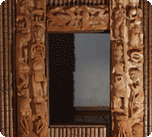 |
|
| The Baham museum | |
| Permanent exhibition | |
| Information | |
Kings and dignitaries
The objects of the cultural and artistic heritage of Baham express not only the essence of royalty nefo (nefeu), but also the hierarchy, the cohesion and social values. For example, royalty and notability are not expressed only by the multiplicity of titles, the number of powers but also and above all by the emblems and symbols represented by objects (seats, sceptres, panther skins, constructions, adornments, pipes, costumes, elephant teeth, statues, etc) and which specify the rank and social position of their holders.
The attributions, the power, the functions and the prestige of the king (feu) and notables who counterbalance the powers of the monarch are also materialised by various symbols, objects of worship and cultural artefacts. Art here is a true visualisation of power and of different aspects of social life. A certain number of animals (panthers, elephants, buffaloes, snakes etc.) are symbols of royal power.
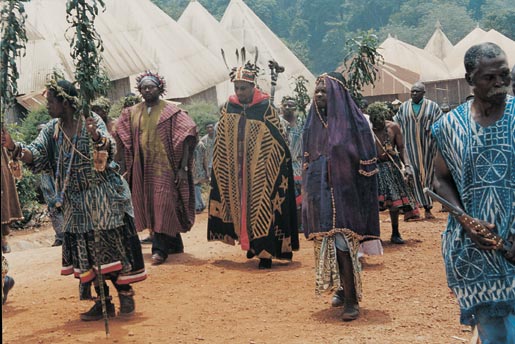
![]() King Pouokam Max II of Baham surrounded by dignitaries
King Pouokam Max II of Baham surrounded by dignitaries
The king fo (feu), a deified figure, exceptional being and representing the ancestors who founded Baham, is at the top of the social hierarchy. He is enthroned after having undergone several religious and magical rituals which have made him a sacred figure and master of the kingdom gung.
He is: the arbiter of all the balances of the group; master of the natural elements; high priest and religious chief; war chief; responsible for traditional justice; overseer of the territory; the living symbol of the fertility and prosperity of his people and the kingdom etc. To take power, in principle the new king must have been born on the “panther skin” (this means that when his father was king and on the throne) and he must succeed his father.
This principle, common throughout the Grassland and history, has some exceptions. Some kings took power by succeeding their brothers whilst others were born before their father came to the throne. This is explained by the fact that the political system and the traditions in the Bamiléké country are not static but always have a capacity of adaptation to deal with new and exceptional circumstances.
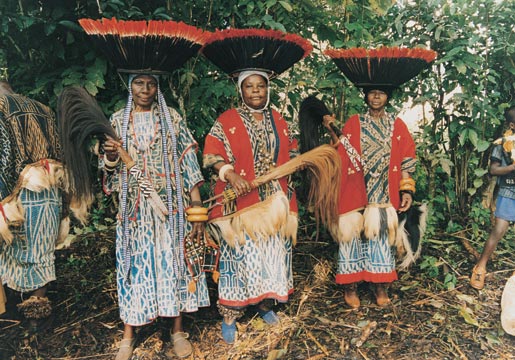
![]() Queen mothers mwemfeu during the dance tseu
Queen mothers mwemfeu during the dance tseu
Le feu est entouré des dignitaires occupant les multiples fonctions et une place précise dans la hiérarchie sociale: les mkamvu’u (les neuf notables, co-fondateurs du royaume); la mafo ou mafeu ( la mère réelle du roi ou sa sœur intronisée ); les serviteurs tshofo ou (tshofeu), futurs prêtres chargés des cultes royaux ou cadres de l’administration du royaume, les uns (tshofosche ou mtcho’chain) en service au palais du feu (et commandés par un tadye) et les autres (pom wa ou kamgué) en formation au fam commandés par les wala’; les wambo ou wabo qui ont fait preuve d’un dévouement remarquable à l’égard du royaume et du feu; l’état major d’un nouveau feu ou de chaque règne.
The feu is surrounded by dignitaries occupying multiple functions and a specific place in the social hierarchy: the mkamvu’u (the nine notables, co-founders of the kingdom); the mafo or mafeu (the real mother of the king or her sister on the throne); the retainers tshofo or ( tshofeu), future priests assigned to the royal cults or administrators of the kingdom, some (tshofosche or mtcho’chain) in serve at the palace of the feu (and commanded by a tadye) and others ( pom wa or kamgué) being trained to the fam commanded by the wala’; the wambo or wabo who have shown remarkable devotion to the kingdom and the feu; the état major of a new feu or of each reign. The feu is at the head of Baham society which has a very strong hierarchy and which includes: the descendants of the feu and the co-founders mkamvu’u; the retainers, the heirs of the retainers of the feu and other nobles who are not of royal blood; simples inhabitants. The division of society into several hierarchical groups according to their ranks remains one of the factors of the permanent struggle for titles to which advantages and honours are also attached. The social stratification, which is strictly respected in Baham, is translated into wearing headdresses and adornments and in the possession of certain objects (seats, houses, furniture, musical instruments, etc). |
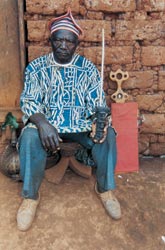 |
|
|
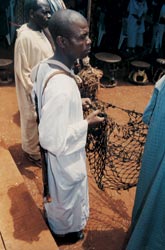 |
These dignitaries whose functions are hereditary and who are also initiated for having followed the new feu to the la’kam (place where the royal initiation is held) are: |
|
|
|
|
|
|
[ Top page ]
| Home | The four museums | The project | Baham museum | Bandjoun museum | Mankon museum | Babungo museum |
| baham@museumcam.org | Copyright 2005 C.O.E. | Powered by SYNUS |































